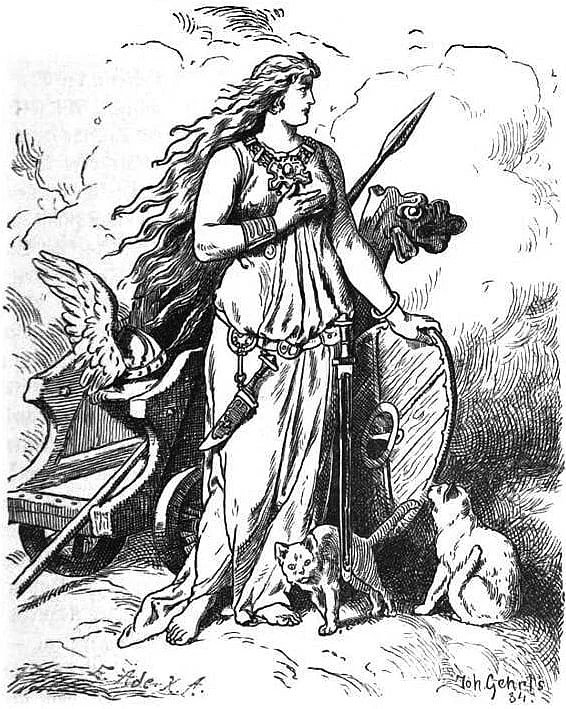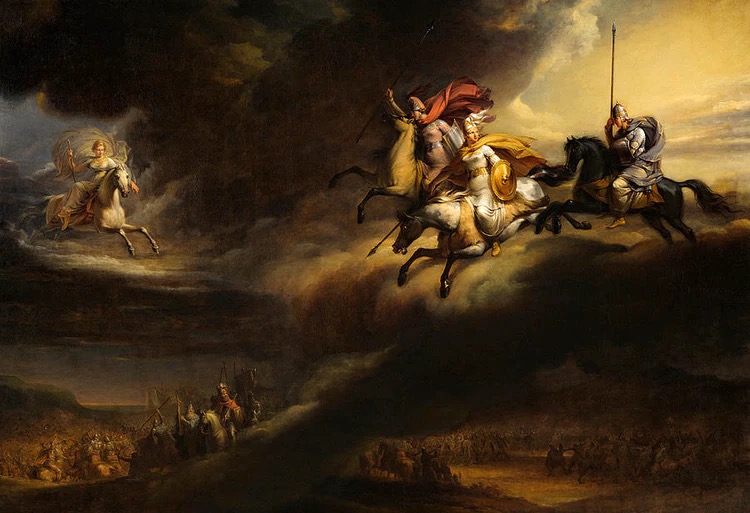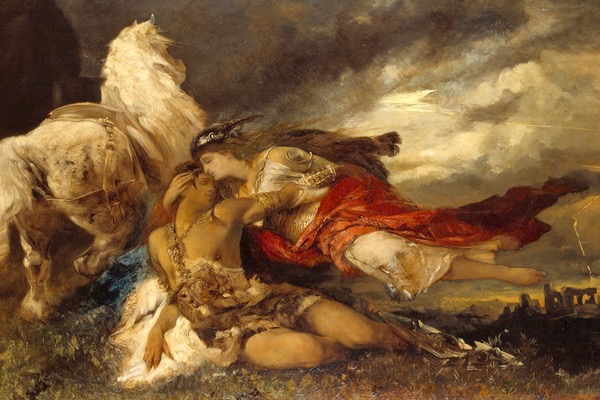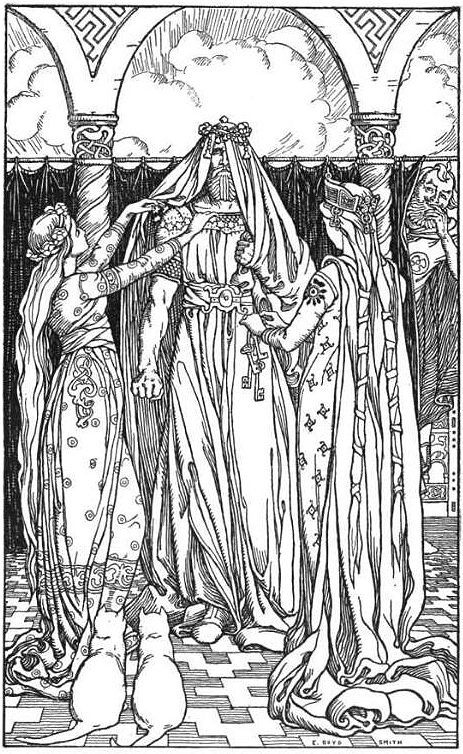Valkyrie, Freyja, and women of the Viking era
A well-behaved woman rarely makes history.
Laurel Thatcher Ulrich
**Trigger warning for blood, gore, descriptions of war and bloodshed**
Freyja’s Chosen
The Norse goddess Freyja chooses her slain
We wind and wind
the web of spears,
there where the banners of bold men go forth;
we must not let his life be lost –
valkyries decide who dies and who lives.

The goddess Freyja stands naked on a battlefield. Runes gleam across the gold headband that adorns her crown. Weapons clash and clang among fierce battle cries. Two ravens circle the gore as the smell of death nears.
In her right hand she holds a shield and in her left, a spear. She walks through the bloodshed with conviction, a fierce gleam in her eyes. The magical Brisingamen glints gold across her necklace. The goddess pauses when she reaches one of the wounded. Planting her spear, she kneels beside him. He takes his last breath, grateful for the sight of her beauty.
Across the mountains, far away from the battlefield, twelve women sit beside a warped loom. They weave strands of bloody entrails through their fingertips, singing songs of bloodshed as they do so. Their melody quickens, and as it does, so does the battle.
Freyja notes the increase in battle intensity. She watches as arrows impale some warriors, while others mysteriously miss their intended targets. Some men live, while others meet a grim fate.
All this is determined by the twelve women who weave the bloody strands miles away. The women delight in orchestrating the battle, and there is much glee in their voices. They sing songs of the battle, as they weave.
“Let us ride swiftly
on our saddle-less horses
hence from here with swords in our hands.”
( stanza 11 “Song of the Valkyries” Njal’s Saga )
Then, as the last of the slain falls, the singing halts. The battle is done. Bodies lie across the field in a deformed gore. Ravens descend to take the eyes of the dead as Freyja walks among them choosing who will return to her hall.
The twelve women mount their steed, taking off at a furious rate towards the battlefield. Weapons at their side, they take to the air, relishing the scent of blood as they near the dead.
Beside them now aboard his eight-legged steed is the raven god. He is on his way to claim the rest of the souls for Valhöll.
Back at the war scene, Freyja has made her selection. She calls to her chariot which is pulled by two enormous felines.
At that moment, the sky opens. Ribbons of green dance across the heavens as the Valkyrie descend through the mist. The wounded souls look to the heavens whispering to themselves, “Valkyrie, oh Valkyrie, take me to glory.”
Freyja mounts her chariot. Upon her shoulders, she dons her feathered cloak which can gift her the art of flight if she chooses. With a single slap of the reigns the two enormous felines spring to action.
Beside her is a boar who will accompany them all the way back to her hall, Sessrúmnir, where she will greet the souls brought by the Valkyrie.
One glance over her shoulder reveals the one-eyed god who has arrived to claim the rest of the slain for Valhöll. He dismounts his steed, Sleipnir, and with a spear in hand, makes his way through the eerie scene. The two ravens depart to gather news from the rest of the nine realms.
The souls of the dead warriors depart the Midgard, awaiting their fate where they will feast and fight until the end of days.
This is the legend of Freyja, the Norse goddess of love and war, and queen of the Valkyrie. She was described as the “most noble” in the Icelandic poems, and all desired her. She is often depicted aboard a chariot which is pulled by two enormous felines and most known for her refusal to marry the giant Þrym to recover Thor’s hammer in the mythological tale Þyrmskviða. But few know the goddess had first claim over the honorable dead, ranking her alongside Odin, the highest of the gods.
The twelve women weaving the bloody loom, who orchestrated the bloodshed were the Valkyrie, legendary battle maidens referenced in Viking sagas and poems.
In the Prose Edda, the Valkyrie was depicted as mead servers and battlefield escorts. In popular culture, they are often depicted as beautiful battle maidens who take up arms beside their male counterparts. Nothing wrong with any of that, however, when we take a closer look at the legends and poems we realize they were so much more.
Stories like the powerful Norse goddess Freyja and fierce women such as Valkyrie surfaced in Viking legend, myths, sagas, and poems, Women of the Viking echo this sentiment, and despite oppression, were noted for being resourceful, strong, and brave, orchestrating conflicts and pulling the strings in the otherworld as magic workers.
In this special International Women’s Day post, I take a closer look at these powerful female figures in Norse legends and how this translated into the everyday life of women in the Viking era. This is part one of my series on the women of the Viking era. Let’s start with the legendary woman known as the Valkyrie.
Valkyrie in legends, myths, and poems

“May he who listens learn from this the tones of spear – -women and tell them to men. ” Stanza 10 “Song of the Valkyrie” Njal’s Saga
The word Valkyrie in Old Norse translates to “she who chooses the slain,” from valr “the battle dead” and kjosa, past tense kuru, that is “to choose.” The feminine grammatical ending throughout Norse texts alludes all Valkyrie being women.
The Valkyrie were depicted as escorts of the slain by 13th-century Icelandic historian Snorri Sturluson in his Prose Edda.
As attested. these beautiful battle maidens were sent to fetch the honorable dead from the battlefields and take them to Valhöll. There they would serve mead as they battled until the end of days in preparation for the Norse equivalent of doomsday, a time called Ragnarök. Not a bad fate, but when we look closer at the legends, there was so much more to these women.
Not only did they escort the souls to the afterlife, but they chose who lived and who died on the battlefield by orchestrating the fates of men involved in the battle.
In Iceland’s most popular saga, Njal’s Saga, we see another side of the Valkyrie through the eyes of a man named Dörruð. Dörruð stumbled upon a horrifying scene when he followed twelve women into a weaving room.
On April 23 1014 the bloodbath known as the Battle of Clontarf in Dublin was fought. Thousands of lives were lost as King Brian Boru of Ireland fought off opposing factions and their Norse allies.
This battle is attested in both the Irish annals and Njal Saga. The saga poetically refers to this battle as “blood rain,” but attributes much of the gore to the agency of women.
This did not refer to women warriors, but supernatural beings known as valkyrie who guide the fate of arrows and blades into the bodies of those they choose. which brings us back to our friend Dörruðr and his horrifying discovery.
The scene I described earlier with the bloody loom was described in the verses Darradarljoð, the song of Dörruðr, also aptly known as the “Song of the Valkyries.”
As the story goes, a man named Dorrudr claims to have witnessed twelve mysterious women enter a house five hundred miles away from the battle of Clontarf in the northern tip of Scotland. When he entered the home to investigate what they were doing, what he saw was a scene straight from a horror show.
The women were weaving on a warp-weighted loom, but it was quite unusual. The warp and weft that made up the fabric were bloody entrails, not yarn, and the weights holding the warp taut were human skulls. The women used swords and blades to weave the fabric while singing songs about the ongoing battle as if they were orchestrating it themselves.
Their chants escalate as the Valkyrie appear to delight in the clashing of swords and bloodshed. As it does, the battle surges, and the Valkyries boast they have the men’s lives in their hands. The victory song ends, and one can assume the bloodshed ceases. The women then tear up the bloody fabric, each holding onto their pieces They exit the building to ride their steeds to the war scene where they will fetch the dead and deliver them to Freyja’s or Odin’s Halls.
Two of the valkyries mentioned in this poem are Gunnr and Gondul, also named in the Eddic text Völuspa where an unnamed seer delivers the prophecy of Ragnarök to Odin.
Another example of the fate of the slain being at the hands of these women is a tenth-century poem about a sea battle. The poet describes the battle conceived as the event known as the “judgment of Gondul.” Two armies clash, and the victor is decided by none other than a Valkyrie.
In the tenth century, following the death of King Hakon The Good Haraldsson, a poem depicts a mortally wounded king Hakon asking the Valkyrie on horseback;
“ Why did you settle the battle thus, Spear-Skogull?”
She delivers the mortally wounded king a matter a fact reply that demonstrates that she had decided not only decided the victor, she did so with neither remorse nor sympathy for the dying king.
In the Viking poem “Hrafnsmal” ( Word of the Raven) the magnificent success of the Norwegian king is by way of conversation with a raven and a Valkyrie. She is described as beautiful, with white-blond hair, and her ability to converse with ravens gives her a distinct otherworldly character.
Viking legends developed the Valkyrie into quasi-human figures who took on new identities, engaged in love affairs, and even were punished into marriage by the Norse god Odin.
In the Poetic Edda in the poem, Sigrdrífumál, Valkyrie Sigrðrifa changes her name to Brynhildr when she leaves her Valkyrie status behind. The saga takes a turn as in her new mortal form, she becomes entangled in a love triangle.
Although the quasi-human Brynhildr doesn’t bear weapons, she single-handedly orchestrates the death of her former lover. This action is a common theme found in the Icelandic sagas such as Laxdæla when Guðrun Òvifsrdòttir orchestrates the death of her two former lovers
Whatever kennings used by the authors, these poems had granted the power over the warrior’s life by the Valkyrie. These myths take the pain, suffering, and bloodshed incurred during wars and make it worthwhile and glorious.
Die an honorable death and be chosen by Freyja or Odin. Die from old age or sickness and spend forever in the cold, mist realm, ruled by the goddess Hel, the half-corpse, half-beautiful maiden daughter of Loki and the giantess Angrboda. ( I will go into more detail about the Norse cosmos and the Nine Realms in another post under my “Not in your Iceland Guidebook Section.” )
Instead of an eternity in the cold, mist world, a warrior is rewarded with eternity in Freyja’s or Odin’s Hall. Rather than death being futile, it is destiny decided by divine beings. Sounds much better right?
So the question is, were these legends all a coping mechanism fabricated by men to make sense of war and bloodshed, or did mortally wounded witness these women on horseback riding through the Aurora to retrieve them?
Now that we know a little about the Valkyrie, let’s talk about that bold and beautiful goddess at the battlefield, Freyja.

Freyja and her mysteries
Freyja is the most noble
Prose Edda; Sturluson, Snorri
Along with Frigg, Freyja is one of the most prominent of the Norse goddesses. She is described in Snorri’s Edda as the most noble and is often depicted as very beautiful wearing a magical gold necklace and feather cape. She is associated with love, fertility, sex, gold, and the slain. Quite an impressive combination. Along with her twin brother Freyr, the due were widely worshipped in the Viking era, and still to this day.
Freyja is often misrepresented as promiscuous and a version of Asgard’s “mean girl,” but if we take a look at the source text nothing could be further than the truth.
There are stories depicting Freyja as a benevolent goddess, taking a foothold in our world to assist a devotee (Iceland’s Flateyjarbok) and wandering out into the world in search of her husband Od, when he disappeared while traveling.
The mythological lore available about Freyja depicts her as shrewd, brave, and resourceful ( she made a feathered cloak to help her fly!) and it is safe to say on the same level on the playing field as the highest of the Norse gods, Odin.
Freyja and the Valkyrie
In the story of Freyja, I had mentioned the goddess donning a feathered cloak which gifted her the art of flight. This magical cloak is mentioned in the Edda, as well as her ability to take animal form.
This ability to shapeshift was also a property of the Valkyrie.
As attested in the Eddic poem Volundarkviða, the Valkyrie take swan shapes to glide through the air.
This ability as well as associations with the slain, war, and death lead many to theorize that Freyja was the “queen of the Valkyrie.”
Freyja and lore
The most well-known story of Freyja is Þyrmsviða in which the jotun Þrym steals Thor’s hammer, Mjölnir. In a classic Norse lore move, the trickster Loki sets off in Freyja’s feathered cloak to ask the giant for the hammer back. He agrees, but only in exchange for the sun, the moon, and Freyja’s hand in marriage.
Loki soars back to Asgard where he and Thor deliver the news to the gilded goddess.
Repulsed by the idea, Freyja vehemently rejects the agreement, snorting so loudly that Brisingamen breaks apart. The gods are desperate. Without this hammer, Asgard is at risk. They meet in counsel, deciding the only way to retrieve the hammer is to send Thor disguised as Freyja to marry the unsuspecting giant.

I especially enjoyed Neil Gaiman’s take on this tale in his book Norse Mythology. This story is also part of my book, Father of Monsters, all the way to Thor donning a wedding dress. It is one of my favorite Norse myths!
As for Freyja, props to her for rejecting the idea!
Other than this, the goddess is a relatively shadowy figure in Snorri’s Edda. She is depicted as benevolent, resourceful, shrewd, and assertive.
In the Eddic text, Grimnismàl, Snorri mentions Freyja receives half the battle slain and Odin the highest god, receives the other half. Despite this statement alluding that Freyja has a similar footing as Odin, Snorri does not elaborate on this for reasons unknown.
In the mythical poem Hyndluljod (The Song of Hyndla), preserved in the Icelandic manuscript, Flateyjarbok, the goddess of love demonstrates what she is willing to do for a loyal devotee.
In this story, a young man named Ottar is concerned about his inheritance being stolen. He asks Freyja for assistance in the matter which will require her to gain specific knowledge from a giantess named Hyndla.
Freyja transforms Ottar into boar form and rides him to the cave-dwelling Hyndla in hopes of gaining this knowledge. This echoes the tales of Odin when he rides his eight-legged steed to the underworld to gain knowledge from a dead seer or engages in dialog regarding mythological lore with a giant in the Eddic poem Vafthrúdnismál.
Freyja first appeals to Hyndla as her “sister” but when this fails, she takes another side and engages the giantess in an exchange of insults known as a flyting. The knowledge is won, and Freyja and Ottar are victorious.
Another popular flyting in the myths is Lokasenna or Loki’s taunts where Freyja is accused by the Norse god Loki of being promiscuous. Although never proven, this is often an assigned characteristic to the goddess, despite it being a common misogynistic trope at the turn of the 14th century.
Freyja, magic, and nature
Freyja and her twin brother Freyr, are both members of the Vanir tribe of gods, who hail from a place called Vanaheim, one of the Nine Realms in Norse Mythology. The Vanir gods are associated with nature and magic, while gods like Odin and his son Thor, are associated with war and order.
The first war between the two tribes of gods ended in a truce. Part of that agreement was that some of the Vanir gods would live in Asgard. This included Freyja, her brother Freyr, and Idunn, keeper of the Apples of Immortality.
Freyja is also believed to be a master of seid, a special kind of magic that involves prophecy, as well as communication with land spirits and the dead. Seid was attested in the Viking era but has existed way before that. Mostly women who took the title of Völva ( also known as seer) practiced seid. They were held in high regard and were depicted as well-dressed and enigmatic in the sagas.
This magic involved the use of a spinning tool known as a distaff, a tool which the proverbial threads of fate were woven around. The Norse goddess Frigg is believed to be a fate weaver and was associated with the distaff so much so that Orion’s Belt was referred to as “Frigg’s Distaff.”
Although the men warred with weapons in Viking legends, it was the women who held fate in their hands.
To the Norse, the distaff was mightier than the sword.
Women in the Viking era
The Valkyrie spirit in every day life
Read any saga or Viking legend and you will see Freyja’s story echoing in the heartbeats of the women in everyday life. Norse sagas tell stories of betrayal, upheaval, loyalty, bravery, as well as revenge often orchestrated by guess who, women. They take full part in power struggles, yet this is not without oppression and exclusion at times due to gender.
In the Viking era, the agency of women and their power over life and death is a recurring theme in not only Norse legends but in everyday life:
A völva was regarded for her ability to foretell the future.
Loyal wives risk their lives to defend their men.
New mothers protect their children with the same fierceness as Valkyrie
Women accompany men as they sail unchartered waters to trade their goods on new shores.
In old Viking society, women played an active role in daily life, pulling strings in this world and the other world. Pick up any saga and you will read about women making difficult decisions for their household, orchestrating murders, plotting revenge, running the household, delivering the fate of men with dreams, and traveling widely.
Much like Freyja, viking women were bold and resourceful determined to advance their social status through good use of their skills and assets.
There are entire books dedicated to this topic so to summarize the duality that exists among women in the Viking era in a blog post is nearly impossible without dissecting experiences based on factors such as age, social class, land ownership, marriage, and skills.
In the next few months, I will be featuring women of the sagas, as each is deserving of their own space to tell their stories. We will be starting with my favorite Gudrun Ovifsrdottir, the woman with four husbands and the lead role of the Laxdæla saga.
Fierce females
Hail to the strong women. May we know them. May we be them. May we raise them.
I wanted to publish this post on International Women’s Day for obvious reasons. I know so many fierce females who are living boldly, taking chances, standing up, speaking up, and taking the lead in their own saga. I’d like to think I am one of them, although some days when I am feeling less than motivated, not so much.
With that being said…
Who are the Valkyrie now? They are me, they are you, they are every fierce woman I know.
To me, the heart of the Valkyrie beats within the bold women. The women who march for equality. The woman who draws her boundaries. The boss babes in the modern era. The one who won’t keep quiet. The one who embodies her sensuality. The single mom running her side hustle because she has a dream to be better one day. The woman who knows what she deserves. The woman who excels in a male-dominated field. The women who heal, and the women who hold shields. The women who fight in wars, and the women who rescue those in need.
The Valkyrie spirit resides in my heart. She will always guide me to do what’s right. To live the life I want. To be bold, take chances, defend others in need, and make just decisions.
She is the weaver of her fate and has confidence in her path forward.
She is to be celebrated just as women ought to be.
I hope you enjoyed this post and learned something about Freyja and her mysteries today! I love hearing from my readers, so feel free to drop a comment and tell me your favorite part or what you would like to read more of!
If you are interested in learning more about Freyja and will be in the Northern Pennsylvania area, I will be hosting a live discussion about her at Earthly Treasures in Milford PA on Friday (Freyja’s Day!) May 3rd from 6- 8 PM. You can find the details here: /https://fb.me/e/1aQE28Rbw
Recommended reading:
Norse Mythology by Neil Gaiman





